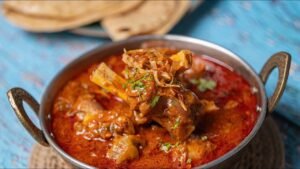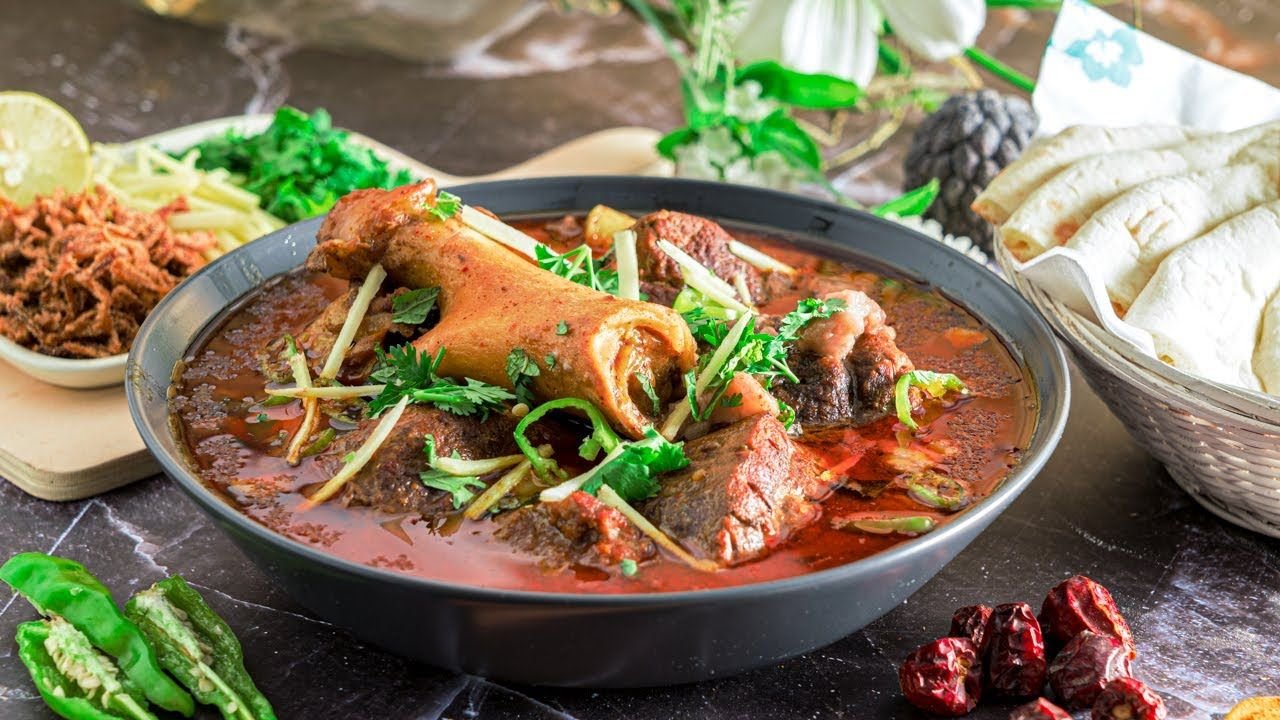Nihari

Ingredients:
For the Nihari Masala (Spice Mix):
– 2 tablespoons coriander seeds
– 1 tablespoon fennel seeds
– 1 tablespoon cumin seeds
– 1 tablespoon whole black peppercorns
– 1 tablespoon cloves
– 1 tablespoon green cardamom pods
– 1 cinnamon stick
– 1 nutmeg, grated
– 1 tablespoon dried ginger powder
For the Nihari:
– 2-3 pounds of beef or lamb, cut into large pieces
– 1/4 cup ghee or vegetable oil
– 2 large onions, finely sliced
– 4-5 cloves of garlic, minced
– 1-inch piece of ginger, minced
– 2-3 green chilies, slit lengthwise (optional)
– 2 tablespoons Nihari masala (from above)
– 1 teaspoon turmeric powder
– Salt to taste
– 6-8 cups water
– 2 tablespoons wheat flour or all-purpose flour (for thickening)
– Fresh coriander leaves, chopped (for garnish)
– Ginger slices (for garnish)
– Lemon wedges (for serving)
– Naan or rice (for serving)
Instructions:
Step 1: The first step will involve preparation of the Nihari Masala.
1. In a very low quantities in warm dry skillet, sauté coriander seeds, fennel seeds, cumin seeds, black peppercorns, cloves, cardamom pods, cinnamon stick until it gives a fragranced smell.
2. Remove the spices from the heat and let them cool down Before you put it into a blender or use a pestle and mortar and blend it to fine powder.
3. After that add in the grated nutmeg and also the dried ginger powder. Set aside.
Step 2: Follow the link to Cook the Nihari:
1. Place ghee or oil over medium heat in a large, deep pot with a heavy base.
2. Some of the ingredients are chopped onions, follow the set down procedures and stir until they reach a brown color.
3. Add the minced garlic, ginger and green chillies which you may use and stir for a few more minutes until the aromatics are well incorporated.
4. Now, place the pieces of meat into the pot, and brown until it turns golden brown on all sides.
5. If using Nihari masala, turmeric powder and salt, ground them and put over the meat and mix well.
6. Add the meat into the pot and then pour sufficient water to cover the pieces & more.
7. For instance, when cooking stews, you will first bring the mixture to a boil and then reduce the heat until you simmer the stew for 4-6 hours. It is also okay to use a slow cooker for this process as well, once it is done, add it to the veggies.
8. Once the meat is cooked, put some water in a plate and enough flour to make a paste that should not be lumpy. To further thicken the gravy, pour this paste into the nihari and mix it in.
9. Let it simmer uncovered for another 15-20 minutes, stirring sometimes from the bottom of the pot with a spatula until you get the required consistency of the gravy.
Step 3: Nihari is ready now time to serve the same,
1. Finally, Sprinkle fresh chopped coriander leaves and garnish the nihari with thin small round slices of ginger.
2. To the dish, accompany with warmed naan or rice and a sprig of lemon.
Enjoy your homemade nihari!
Calories in Nihari:
Nihari, an aromatic and aromatic stew has a rich history and is highly preferred for its taste and potential health benefits. Let’s delve into both sides:
History of Nihari:
Origins: Nihari is a preparation of meat that emanated from the kitchens of the Mughals during the late medieval era in the Indian subcontinent. Earlier, it was a breakfast food consumed by the nawabs and upper classes of Delhi to ward off the chilly winters, as the dish was quite heavy and hot.
Evolution: Showing the journey from the royal cuisine, then becoming the simplest road side and homely dish, nihari trickled down to all portions of the Indian subcontinent with large Muslim populace such as today’s Pakistan and Bangladesh. Every country prepares its specialities with spices and has its own peculiarities, but the slow method of cooking with spicy gearing remains unchanged.
Cultural Significance: Nihari possess social importance considering it is prepared mostly by Muslims and consumed during feasts and celebrations such as sundays, births, marriages, and other festive occasions. Greetings prevail over the Restaurant business and it is one of the important symbols of food heritage of the Indian subcontinent.
Health Benefits of Nihari:
Nutrient-rich: It usually consists of different types of meats like beef or lamb, which are good sources of protein consists of. Further, the slow cooking system helps prepare juicy and tender meat with no significant compromise of its nutrient content.
Spices: The spice used in nihari such as coriander, cumin, cloves, cinnamon and some others which are used in nihari has the potential to be good for health since they are well known to be healthy spices to be used in food preparation. Most of these spices contain anti-oxidant, anti-inflammatory and carsinogenic properties with some acting as digestive agents.
Bone Broth: Due to the long and slow cooking process of nihari by raw meat and bones it gives a lot of nutrients like collagen and gelating material and other minerals like calcium, magnesium and phosphorus. Some of the nutrients which are beneficial for the health of joints, health of stomach, and immunity of body are as follows.
Energy Booster: Because of its rich content and combination of different ingredients, Nihari is a perfect meal for stronger energy supply – as the recipe is perfect for cold time of the year or after days of fasting, like in the course of Ramadan. The components regarding protein, fat, and carbohydrates contribute to maintaining power during the entire day.
Comfort Food: Empathetically, besides the physical nourishment, nihari also offers psychological relaxation as more of a comfort food. Cinnamon has a multi-layered, sweet and warm smell; its taste and texture is filling and can even create a state of euphoria, which can be helpful when a person is stressed or tired.
Conclusion:
Nihari’s evolution from the elite cuisine of the Mughals to the factories of modern kitchen tables around globe symbolizes it’s timeless value. Not only does it taste good, but nihari also provides a number of possible advantages that associated with our health, so this is an excellent dish that can be recommended to almost anyone. Regardless, if it is set up from the very start of the day or ordered in a festive hurry, nihari remains a favorite and cherished dish for many gourmands and epicures of the globe.

2 thoughts on “Nihari 2024”
Comments are closed.